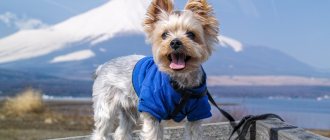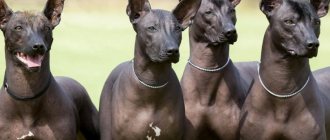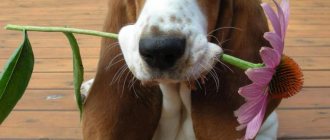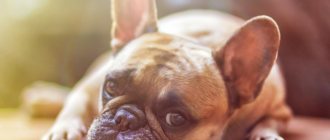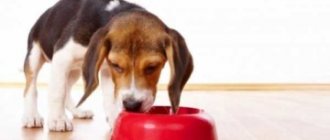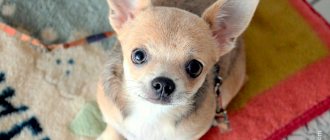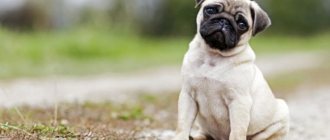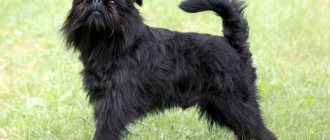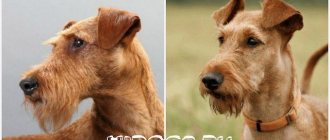The ubiquitous hairs are especially annoying for allergy sufferers. Therefore, future owners are looking at dogs that do not shed. Such dogs are not only less “hairy” than their shaggy relatives, but also have almost no odor and are hypoallergenic.
You will learn which dogs are non-shedding, which one is better to choose and how to care for them from the rating of the 10 most hassle-free breeds.
What does molting depend on?
Shedding is the natural process of renewing the coat. It can be of several types:
- Seasonal. Occurs in autumn and spring. When the air temperature drops, the fur coat (undercoat) becomes thick and warm to warm the animal during the cold season. In spring, when the air temperature rises, the fur becomes lighter due to changes in the structure of the coat.
- Age. Occurs during the change of a puppy's coat to that of an adult animal.
- Biological. When a dog mother stops feeding her babies milk, she also experiences intense hair loss.
- Caused by stress: animal disease, medications, unbalanced diet, lack of vitamins. In particular, a lack of vitamins such as B2 and B3 can lead to hair loss.
Hair shafts emerge from the same follicle, replacing each other after dying off during molting. As a result, the total amount of hair does not change despite shedding. But in some breeds the hair lives for a very long time without replacing each other. This is the type of coat that dogs have that do not shed.
The type of coat also has a great influence on the intensity of shedding. In dogs, it consists of guard hairs, which can be long or short, and an undercoat, formed of soft short hairs. It is the undercoat that provides the animal’s thermal balance and is replaced during seasonal molting.
Different breeds of dogs have one or another type of hair predominant. For example, the Yorkshire Terrier has no undercoat, and the Mexican Hairless Dog has guard hairs.
Labradoodle
The Labradoodle is the result of a successful cross between a Labrador Retriever and a Large Poodle. As a result of thoughtful actions of breeders, the resulting individual not only has an attractive appearance, but is also considered a hypoallergenic animal. Labradoodles are classic pets for the whole family due to their gentle nature and gentle disposition.
Unfortunately, these dogs are not at all common in Russia; they are almost impossible to purchase from an official breeder. Therefore, dog breeders advise going to Poland or Finland in order to purchase a purebred representative of the breed, without fear of encountering a fake.
Labradoodle
Hairless rocks
The so-called hairless dogs are the first group that includes dog breeds that do not shed. These include:
- Chinese Crested: hairless and downy;
- Peruvian hairless: small – up to 8 kg with a height of up to 40 cm; medium – up to 12 kg with a height of up to 50 cm; large – up to 23 kg with a height of up to 60 cm;
- Mexican Hairless, or Xoloitzcuintle: hairless and with fur;
- American Hairless Terrier.
The history of the appearance of hairless dogs is shrouded in an aura of mystery. By comparing the legends and myths telling about dogs without hair, we can conclude that the ancestors of hairless dogs existed in countries with a hot tropical climate on all continents, excluding Australia. It has not yet been reliably established whether dogs moved from continent to continent during the migration process, or whether they simply contained related characteristics, or were formed as a result of similar mutations.
Constant exposure to a hot climate has led to hair loss (in some varieties it is retained only on the fingers, the tip of the tail or the head in the form of individual bristles), and an even distribution of sweat glands throughout the animal’s body.
A bare body, on which hair is partially or completely absent, gives the appearance originality and charm and is the answer to the question of which dogs do not shed.
An important bonus for apartment living is its small size and the absence of hassle associated with shedding: no need to cut, comb, or collect wool scattered around the apartment.
However, caring for this category of dogs has some features:
- weekly bathing;
- thorough skin treatment;
- the use of sunscreen to prevent burns during summer walks;
- wearing clothes in winter when going outside.
Your pet should be given a warm bed, otherwise he will constantly strive to jump into his owner’s warm bed.
List of non-shedding breeds
Non-shedding dogs are a myth. But low-shedding animals, in which this process is not noticeable at all, do exist. And these are not only decorative breeds, but also animals of quite impressive size.
Small dogs
In addition to the absence of excessive hair loss, one of the pleasant features of non-shedding pets is that the dog is odorless. These animals include the following breeds:
- The Yorkshire Terrier is a companion dog that gets along well with all family members. Height from 15 to 17 cm, weight from 2 to 3.2 kg. Does not require special care. It is enough to get a haircut once every few months.
- Maltese lap dog - height at withers from 20 to 25 cm, weight from 3 to 4.5 kg. Sheds little due to the lack of undercoat.
- Brussels Griffon - height 17-20 cm, weight from 3 to 7 kg. The fur does not come out, but it requires periodic plucking.
- Shih Tzu - grows up to 27 cm, weighs from 4 to 8 kg. The coat is thick and requires frequent brushing and bathing.
- The Chinese Crested is a dog with hair instead of fur. Height up to 33 cm, weight up to 5.5 kg. Hair grows on the paws and head, although there is a type of breed that is completely covered with hair. Requires careful hygienic care, because the wool tends to get tangled.
Additional Information! For miniature breeds, it is enough to trim them once every 2-3 months to keep their coat in good condition.
The lapdog is a unique example, despite its long hair, it does not shed
Average
Not only a small decorative dog is distinguished by the absence of falling hairs and an unpleasant odor. Such characteristics are also characteristic of medium-sized animals. Names of the most common breeds:
- poodle;
- Basenji. An interesting feature of the breed is the absence of barking, which is why it is called the “African silent one”;
- Peruvian bald - the skin is covered with barely visible fluff;
- Mexican Hairless - the breed consists of several subspecies, both quite large in size and very miniature;
- Portuguese Water Dog - no shedding hair, but needs trimming.
Medium-sized dogs that do not smell like dogs, regardless of the type of coat, periodically change hairs, but they fall out so little that it goes unnoticed.
Big dogs
Many people think that large dogs are smelly and shed a lot. But that's not true. Therefore, when choosing a puppy, you should know which dogs do not shed but still have thick hair:
- Tibetan Terrier;
- Irish Wheaten Terrier;
- Italian greyhound;
- fox terrier;
- Scottish Terrier.
Additional Information! Surprisingly, the Komondor breed, which is distinguished by its incredibly thick and long hair curled into dreadlocks, is not prone to hair loss at all.
It's hard to believe that the Komondor doesn't shed
Chinese Crested is a typical representative of hairless dog breeds
Since ancient times, the breed has symbolized financial well-being, status and the honorable place of the owner in society. The houses of nobles and palaces most often became the place where these friendly, energetic little ones were kept.
Chinese Cresteds are dogs that do not shed. At the same time, the psychological portrait of the corydalis, compiled according to reviews from the owners of this amazing breed, is very attractive:
- activity and mobility;
- complete absence of aggression and anger;
- inexhaustible curiosity;
- cheerful and cheerful disposition;
- devotion to family members;
- sociability;
- kindness towards other animals;
- fearlessness;
- high intelligence;
- easy to learn and artistic.
Corydalis cannot stand rough treatment; they suffer from frequent quarrels and scandals in the family.
The graceful Chinese Crested can be coated or completely hairless. In the second case, the hair forms only a crest on the head, partially covering the tail and the lower part of the paws. The skin is smooth, soft and warm. With proper care, there is no smell at all.
The downy variety has long hair that flows in a soft veil. The coat needs to be combed daily or trimmed once a month to prevent tangles from forming, since the dog is not prone to shedding.
The Chinese Corydalis, like a real aristocrat, loves cosmetic procedures, strives to be in the center of everyone's admiration, and loves to dress up. Stylish outfits give her additional impressiveness, and her innate flirtatiousness creates a special charm.
It is believed that Chinese crested “balds” protect good luck and happiness in the home and become guardian angels of family members.
Chinese Crested Dog
There are two types of Chinese Crested dogs: Hairless and Powdered. Downy individuals have both a thick undercoat and a large number of outer hairs. Hairless dogs are also covered with hair, but it is so thin that in appearance these animals can easily be mistaken for “hairless”, which is why they received this designation.
Hairless Chinese Crested Dog
Exterior Features
You can recognize a Chinese Crested dog by the following criteria:
- at the withers, representatives of the breed grow up to thirty centimeters;
- the weight of mature individuals fluctuates around 5-6 kilograms;
- The head of Chinese crested dogs is covered with a kind of “mane”, and there is usually a tassel at the tip of the tail. The animal's paws are also covered with hair;
- The skin color of representatives of the breed often changes under the influence of sunlight, but in general it has a gray tint;
- The coat color of the “Chinese” is found both solid and spotted;
- In downy dogs, the ears can be in either a hanging or standing position. Hairless dogs can only have erect ears.
Chinese Crested Dog puppies can be either hairless or fluffy
By the way! Even when crossing two hairless crested dogs, fluffy puppies are often found in the litter. This rule also applies in the opposite direction - with fluffy crested dogs. Therefore, it is almost impossible to influence the birth of puppies with one or another hair covering.
You can read below about how to trim a hairless Chinese Crested dog.
Grooming a Chinese Crested Dog
Maltese
Maltese dogs have a soft, silky coat that you will never find in the most unusual places during shedding periods. The Maltese's coat can be either long or trimmed short. Short haircuts are suitable for those owners who do not want to spend a couple of hours bathing and then brushing their pet.
Maltese
Note that the absence of shedding does not relieve the dog of dying hair, which you, one way or another, will have to comb out of your pet by hand. If you neglect this procedure, the wool will begin to gather in tangles and lose its neatness and prettiness.
Character
Maltese dogs are great for both experienced dog owners and beginners as they are very sociable and open to interaction. They get along easily not only with the owner, but also with other animals, if any are present in the apartment. If you start raising a pet from childhood, you can get an obedient dog that skillfully follows commands and is able to stand up for itself during a walk.
Despite their harmless appearance, lap dogs are ready to selflessly protect their owner.
Maltese dogs have the following set of external characteristics:
- dogs of this breed reach no more than 25 centimeters in height;
- The average weight of a mature Maltese is around 3-4 kilograms. Significant deviations from these figures indicate either emaciation or obesity;
- The coat of Maltese dogs is smooth and heavy. Any curls or waves are unacceptable and constitute a deviation from the recognized standard;
- The coat color is predominantly white (slight ivory is allowed). The presence of a reddish tint or spots is unacceptable.
The body structure of a lapdog depends on its type - there are American and European individuals, which have differences that are noticeable even to the naked eye. The American lapdog is more compact and even looks like a toy dog, while the European one has a stronger and more elongated body.
American and European varieties of the breed
The breed is classified as decorative. The height of the Maltese does not exceed 25 cm. This dog is a good companion, cheerful, affectionate and energetic. The dog loves his owner very much and, despite his small size, may try to protect him. Loneliness has a bad effect on the lapdog's nervous system.
Maltese dogs are very friendly towards other dogs, cats and small animals.
The breed practically does not shed. The coat requires trimming or regular combing.
Breeds with long hair
Dogs that do not shed and do not emit an unpleasant dog odor are represented by the following long-haired breeds:
- Yorkshire Terrier;
- Irish Soft Coated Wheaten Terrier;
- bichon frize;
- Maltese.
Due to the fact that the long hair of these dogs does not fall out during seasonal shedding, but continues to grow, it requires special care. Systematic combing will not only prevent the formation of tangles, but will also turn your pet into a thick cloud of long, silky hair. Such dogs invariably delight others, and in the apartment they do not create problems due to falling hair.
Medium and large breeds of non-shedding dogs
If you have appropriate living conditions, you can consider these types of breeds - no less beautiful, intelligent and kind than decorative ones.
Fox terrier
There are smooth-haired and wire-haired fox terriers. The standard was officially registered in 1876. Still used for fox hunting. As a pet, a dog is invaluable in homes with children. This is the best friend of kids, as well as those who like to actively spend their free time. Possessors of a fearless character bordering on recklessness. They easily rush into an “attack”, even if the enemy has visible physical superiority.
Scottish Terrier
Proud, independent and stubborn, the Scot can always stand up for himself. The small size of the dog creates a misleading impression of its fragility and defenselessness. The breed is a hunting breed, so it requires long walks and regular exercise. Small stature is more than compensated by powerful paws, neck and teeth. Rarely barks without a reason, adapts perfectly to both urban conditions and life in the countryside. The coat is long and hard, turning on the muzzle into a characteristic mustache and beard. Color options: brindle, black, beige.
Basenji
Region of origin: Central Africa. One of the most ancient dog breeds. Basenjis cannot bark and can only make quiet rumbling sounds during periods of excitement or agitation. They are very active, smart, graceful and have excellent health. In terms of cleanliness, they are often compared to cats. Unpretentious in maintenance and physically hardy. They are considered absolutely hypoallergenic, do not smell and do not shed.
Italian Greyhound
The trace of the Italian greyhound can be traced back to the times of Ancient Egypt, as evidenced by numerous drawings and images of the dog in paintings, vases and household items in the homes of the pharaohs. Its popularity flourished during the Renaissance. Italian Greyhounds are graceful, friendly and active. However, due to their fragile constitution, they are prone to injuries, especially when playing with children. Despite their weak sense of smell, they are well oriented in space and have a quick reaction. They often growl and bark, so they can create problems for neighbors if kept in an apartment building.
Irish Soft Coated Wheaten Terrier
Another non-shedding breed, developed in Ireland over 200 years ago. The Wheaten Terrier was bred by the so-called “folk” selection method by crossing dogs that lived in peasant houses. The name clearly speaks about the main advantage of these terriers - silky, soft, velvety coat the color of mature wheat. The dog is energetic, curious and playful, but at the same time very balanced and intellectually developed. Thanks to its courageous character, it can be used not only as a pet, but also to help manage livestock, and also serve as a watchdog.
Portuguese water dog
A hunting breed developed in the Middle Ages in Portugal. Initially used by fishermen to drive fish into nets, search for lost fishing gear, transmit messages from one ship to another, etc. He has a calm, balanced character, excellent health and good mental abilities. The coat is thick, does not shed, is hypoallergenic, and has a water-repellent impregnation. An ideal workhorse, never tired and always full of energy. On average, dogs live 11-13 years.
Tibetan Terrier
They are not included in the group of terriers and owe their name to Europeans, who at one time discovered the similarity of dogs with this breed. For many centuries, dogs lived in Tibetan monasteries, serving the monks as companions. They were considered by the local population as a talisman of good luck, so families treated them as relatives and natural children. They are distinguished by enviable intelligence and an ideal sense of balance. They are easy to train and quickly adapt to the character and habits of their owner. They cannot stand loneliness. The average age of life is 12-15 years.
As you can see, the choice of non-shedding dogs is quite large and varied. All breeds have their own personality and are suitable for home keeping.
Bichon Frize
The Bichon Frize is a small breed, up to 30 cm at the withers. These decorative dogs are sociable, affectionate and energetic, and need attention. Although Bichons are active, they do not need long walks.
The Bichon Frize gets along well with other pets and children.
Dogs of this breed do not shed and rarely cause allergies. They need to be brushed daily and can be trimmed to make grooming easier.
The Bichon Frize joins the collection of miniature dogs with airy snow-white fur. Many owners of this charming dog compare it to an angel - both in external qualities and in character. It seems that these animals are not capable of harming anyone; they quickly become attached to people and become their faithful companions. Like other non-shedding dogs, the Bichon Frize needs daily brushing to avoid mats.
Translated from French, Bichon Frize means curly dog.
Small breeds of non-shedding dogs
The fashion for small lap dogs continues unabated. And not only because of their toy appearance, but also due to the lack of odor and shedding. The following breeds are ideal for home keeping:
Maltese
Glamorous and sophisticated “native” of the Mediterranean. However, despite his doll-like appearance, he has a very capricious and wayward character. He is jealous of children, afraid of not being the center of attention. This little dog is a real energizer, capable of getting even the laziest household members off the couch. Not prone to excessive shedding and is perfect for keeping in small apartments. The average life expectancy is 15-18 years.
Yorkshire Terrier
An ornamental breed bred at the end of the 19th century in England (Yorkshire). Brave, smart and self-confident dogs who, without hesitation, will bark at anyone who encroaches on the integrity of their owners. Yorkies were originally bred to hunt rodents and were slightly larger in size. As a result of selection, the current standard was developed, which suits lovers of small indoor dogs quite well. The most common color types are golden-black, dark with tan, and golden-blue.
Shih Tzu
It is believed that the homeland of the Shitzu is China, but its reliable origin has not yet been identified. Translated from Chinese, Shih Tzu means “lion cub”. Dogs came to Europe at the beginning of the 19th century. Owners of the longest fur relative to body size. They practically do not shed and do not smell, so they are “regulars” of city apartments where allergy sufferers and small children live. Despite their toy appearance, they have a strong build and boast enviable strength indicators. They absolutely cannot stand loneliness and follow their owner everywhere. The most common dogs are white-golden, white-blue, cream, brown and spotted-black.
Brussels griffin
Country of origin: Belgium. The first mention of the breed dates back to the 18th century. At home, dogs were used to catch rats, gradually “evolving” from stables to home living rooms. Very smart, quick-witted and intellectually developed. They have a strong athletic build and are able to withstand severe physical exertion. The coat is hard, thick, and has a wiry structure. The color is usually red with various shades. Due to their textured muzzle, which is similar to a human face, griffons are often filmed in films and appear in various television programs.
West Highland White Terrier
The homeland of the West Highlands is Scotland. The original purpose is hunting small game. Due to their miniature size, the dogs easily penetrated into any holes and were a threat to foxes, badgers, etc. Today they are more used as decorative pets. Cheerful and restless, they love long walks outside. The character is stubborn, courageous, but at the same time very light and peaceful. The coat is of medium length, quite hard, in contrast to the undercoat, which is soft and fluffy, similar to fur. They practically do not shed, but regular trimming is required.
Miniature Poodle
Two countries are fighting for the right to own this breed: France and Germany. Initially, dogs were used to pull ducks, geese, quail and other game out of the water. As a result of selection, poodles acquired a decorative purpose, but at the same time they did not lose their sense of self-esteem and inner charisma. Their ability to train has made them regulars at circuses, and thanks to their luxurious silky, soft and fluffy coat, the dogs stand out noticeably from their four-legged relatives. They have a good-natured, easy-going character, get along well with children and tolerate loneliness quite painlessly. They do not have the characteristic dog smell.
Bichon Frize
Translated from French, the dog's name means "curly lapdog." The color is exclusively white, the height does not exceed 30 cm at the withers. The character of Bichons is quite complex, but with proper training it is possible to find a common language with the owner. Along with being hypoallergenic, odorless and shedding-free, this breed is easily litter box trained. However, due to increased activity, energy and playfulness, the dog requires regular walking. She is very curious by nature and not aggressive.
Chinese Crested
The homeland of dogs is presumably Mexico or Africa. How they got to China is not known for certain. The breed has no hunting roots and was bred exclusively for home keeping. Chinese Cresteds can be either completely hairless (separate patches of hair on the limbs, head and tail), or covered with soft veil-like hairs - the so-called puffs. They are odorless and do not shed. Active, cheerful and cheerful. They are loyal to their owner and very careful around strangers. They can live up to 18-20 years.
The Irish Soft Coated Wheaten Terrier is a long-haired, non-shedding dog.
A friendly intellectual, an obedient pet, a devoted friend, a dog with excellent health - these are the general characteristics of this variety of Irish Terrier.
His fur always delights those around him. The color of ripe wheat, soft to the touch, it falls in a thick silky wave. At the same time, seasonal shedding in the Soft-Coated Terrier is almost not pronounced due to the lack of undercoat. These are dogs that do not shed: winter cold and summer heat do not affect changes in the length and structure of the coat.
The wheaten terrier acquires its final golden appearance by the age of two. Puppies are often gray or red in color and have straight hair. Only in the process of growing up does a special waviness of the single-layer coat appear, which has the same length on all parts of the body, covering the dog with a solid golden cascade from head to paws.
Brushing after bathing prevents the appearance of tangles and gives the dog a special charm.
Scottish Terrier
Scottish terriers are known for their changeable character - friendliness and openness can coexist in them with irritability and detachment, replacing each other several times a day. Such pets, prone to dominance, need early socialization, which will allow them to accept other animals without entering into conflict with them. In this regard, Scottish Terriers are more suitable for experienced owners who can show the pet “who is the leader” without becoming aggressive.
Scottish Terrier
Exterior Features
Scottish Terriers are considered the most recognizable among all other terriers. The following characteristics make this breed unique:
- Scottish terriers do not grow higher than 30 centimeters at the withers;
- the weight of mature individuals of this breed ranges from 8 to 10 kilograms, depending on gender and body type;
- First of all, the stockiness of Scotch Terriers is noticeable, the reason for which is the short limbs combined with a deep chest, which further conceals the length of the animal’s paws;
- Scottish terriers have a strong bone structure, which reflects the roots of the working dogs from which this breed originated;
Hunters by nature, Scottish Terriers can be sharp and obstinate
- Despite their stockiness, representatives of the breed have a long neck, on which is located a voluminous head, elongated in length. The head and muzzle of the Scotch Terrier are flat, it is very difficult to distinguish them from each other due to their thick, long hair;
- The density of the Scottish Terrier's coat can be the envy of many breeds, since it combines a thick undercoat and an equally thick outer coat. A developed coat is a means of protecting the terrier from cold winds, which are not uncommon in its homeland;
- The fur of representatives of the breed is traditionally black, but there are individuals of brindle and fawn colors.
Scottish Terrier color options
Irish Water Spaniel
The Irish Water Spaniel has a long history. A hunting dog and companion, the Irish Water Spaniel is a friendly, active and loyal breed.
Interesting Irish Water Spaniel fact: Their coat requires regular grooming, but the breed is considered non-shedding and hypoallergenic as it has less dander than many other dogs.
Breeds with short hair and short or no undercoat
Dog breeds that do not shed or smell are also included in the group of those with short hair, consisting of coarse guard hairs. The undercoat is very short or completely absent. As a result, wire-haired dogs leave virtually no hair on the sofa, clothes or carpets and no odor.
Dog breeds that don't shed:
- Brussels Griffon;
- West Highland White Terrier;
- Wire-haired fox terrier;
- Scotch Terrier;
- Cairn Terrier;
- Airedale;
- Staffordshire Bull Terrier;
- miniature schnauzer;
- Giant Schnauzer.
Due to the fact that the undercoat is not subject to seasonal cleaning, the wool must be plucked (trimmed). This procedure allows you to turn your Brussels Griffon, Terrier or Schnauzer into an elegant and handsome dog. With proper care, the thick, smooth and coarse coat protects the dog in all weather conditions. The pet does not get wet in the pouring rain, dries quickly, does not get hypothermic in winter and does not overheat in the heat.
Which dogs don't shed
There are many breeds in which the hair that has come out does not fall off, but remains in the undercoat. There are no dog breeds that do not shed. An excellent pet that practically does not shed would be the West Highland White Terrier. Dogs grow up to a maximum of 10 kg and are friendly and attentive. This breed of dog is a hunting dog, but has a friendly disposition and behaves well with children. This dog would be an excellent companion for someone who is allergic to dog hair.
People living in big cities and apartment buildings prefer to choose decorative dog breeds as pets. Most small dogs do not smell or shed. The following dog breeds cause the least amount of trouble for owners:
- Chinese Crested;
- Bichon Frize;
- Maltese;
- Miniature Poodle.
A wonderful companion - a recently popular breed of dog, the Bichon Frize.
The animal is energetic, has a cheerful disposition, loves increased attention to its person and, importantly, does not have the characteristic smell of a dog. This breed of dog is less susceptible to the seasonal molting process than others.
Bichon Frizes are hypoallergenic dogs. Their fur is soft and surprisingly does not provoke the development of an allergic reaction. But only if you take care of the coat, comb and trim it regularly. Due to the fact that Bichon Frizes have white fur, they need to be bathed regularly. Therefore, from a very early age, they will be taught to take water procedures. Non-shedding dog breeds include toy poodles. Smart kids, active and smart. They are easy to learn commands, have no odor and practically do not shed. In order to reduce the amount of hair during seasonal shedding, the dog must be regularly bathed and thoroughly combed.
Another type of dog that does not smell like a dog is the Maltese. This is the ideal companion for a small child. They treat their household with care, but are also good protectors. Their coat is snow-white. Due to the fact that their hair does not fall out on their own, but the process of changing hairs occurs, it is necessary to comb your pet regularly. In the absence of proper care, the hair that has not fallen out, but has faded, falls into tangles, which then need to be cut, sometimes to the point of bald patches. Therefore, most owners of Maltese dogs prefer to cut their hair short in grooming salons.
A dog that has virtually no hair and therefore does not shed is the Chinese Crested. They are wonderful companions and extremely devoted to their owner.
In order for your pet to feel good, it is important to properly care for the animal's bare skin. Every day, the dog must be treated with special creams to prevent dry skin and apply sun protection products.
In the cold season, the dog must be additionally insulated. Large and medium-sized dogs that practically do not shed are represented by the following breeds:
- royal poodle;
- fox terrier;
- Basenji.
The Basenji dog breed is an excellent choice for people leading an active lifestyle. Pets have no odor and, with proper care, practically do not shed. Basenjis cannot tolerate long separations from their owner, so such pets are not suitable for those who are constantly busy with work.
Experienced dog breeders recommend getting a fox terrier with a rough coat. Smart, agile and unusually active dogs make excellent companions.
But it is important to remember that these dogs are the least controllable. They definitely need to be trained
Otherwise, a little robber will live at home.
The main rule for caring for fur is regular washing, combing and trimming (plucking the fur). Like Maltese dogs, Fox Terriers' hair does not fall out. Therefore, it is necessary to regularly comb your pet using a special tool - a crop cutter. This will help get rid of existing mats of matted wool and prevent the formation of new ones.
For people suffering from allergies to dog hair, a royal poodle is an excellent pet. These dogs are the least troublesome in terms of shedding. They don't shed and don't smell like dogs. Unusually active, playful and intelligent. They train well and are happy to follow commands. As with all previous low-shedding or non-shedding dog breeds, the Royal Poodle requires proper grooming. Regular haircuts, combing, bathing are an integral part of proper care.
Among the dog breeds that do not cause allergies in humans are also Giant Schnauzers, Dachshunds and Labradors. They leave little fur in the house during the molting season.
Scottish Terrier
The Scottish Terrier is a hunting breed and can also be a good watchdog. The dog's height is up to 28 cm. The dogs are energetic and stubborn, but nevertheless loyal and amenable to training. Suitable for both villages and cities, but physical activity and long walks are required.
Scottish Terriers are reserved around strangers and do not get along well with small children.
Scotch Terriers have long, shaggy hair. Since the dog sheds little, it needs to be brushed regularly to remove dead hair.
Wirehaired Brussels Griffon
When answering the question of which dogs do not shed or smell, one cannot help but pay attention to the Brussels Griffon. His fur is hypoallergenic, which makes the friendly guard especially in demand in families with children.
Owners of griffins speak of the breed with respect. The character is cheerful and devoted, obedient behavior, curious appearance - this is how you can characterize the Brussels Griffon. Strongly developed sense of self-esteem. Easy to train. Gets along great with children. With his friendly but confident behavior, he inspires respect from other animals.
The griffin's coat does not shed, so it needs trimming. A simple haircut will not give the desired effect, since it does not remove old, thinning hair that grows back. The coat becomes dull and unsightly. To avoid this, dying hair shafts need to be plucked. This procedure is repeated 2 to 4 times throughout the year. This creates certain difficulties in caring for the pet, but is fully paid off by the cleanliness of the apartment and the well-groomed, neat appearance of the pet.
Chinese Crested: does not shed and does not smell
Chinese Crested: does not shed or smell.
In this case, the hair is only on the head and paws. Therefore, the Chinese Crested breed sheds extremely rarely. But there is also a minus. In countries with harsh climates and severe frosts, it is better not to have representatives of this breed. They are too “frozen”. Of course, you can buy special clothes for dogs, but even a temperature of -5 degrees is a test for them.
If you are wondering how long dogs of this breed live, read the article on our website at this link . This article describes other dog breeds.
Can a dog smell nothing at all?
The peculiar smell of a dog is its calling card. A popular joke says that the only thing that doesn't smell like dog is a toy animal. Thanks to scent, animals communicate with each other.
If the owner carefully monitors the pet, bathes it regularly, and observes hygiene requirements, then there will be no smell.
Poodle: royal, toy, toy
This breed stands apart from other groups due to certain characteristics. The Poodle has both long hair and an undercoat, which is usually the main source of odor in dogs. But we can safely say about poodles that they are dogs that do not shed and do not smell.
Poodle wool has a special composition, things knitted from it have a healing effect on joints, look elegant and festive.
The breed is unique in that a poodle sheds only once in its life, when at the age of 8 months the puppy's coat is gradually replaced by an adult coat. Subsequently, the dying hairs do not fall out, but are retained in dense curls of wool, gradually creating a felt cover. To prevent this from happening, the poodle needs to be combed at least 2 times a week. The procedure is performed with a comb with sparse large teeth, and then continues with a massage brush.
The sebaceous glands on the skin of a poodle almost do not work, so the coat is protected from grease and does not smell.
Small dogs for allergy sufferers
There are relatively small breeds of dogs whose fur rarely causes an allergic reaction. Here are the main ones:
- The Maltese is a companion dog, loves to be close to its owner, and is happy to participate in all household chores. However, the animal's long coat requires constant care and regular visits to the groomer. In this regard, this breed is quite difficult to maintain.
- Shih Tzus are dogs with beautiful fur and a lively mind. Shih Tzus are very intelligent and independent. They make wonderful companions for children and other pets.
Basenji: cleanliness, neatness, lack of odor
A breed such as the Basenji can also be included in a special group. It cannot be fully stated that these are dogs that do not shed. Their hypoallergenic coat is subject to seasonal shedding, but to a small extent. Caring for the dog is made easier due to the fact that Basenjis lick their fur, like cats.
They also have another unique feature - the inability to bark. Instead of the usual barking, only a low howl combined with snorting is heard.
Agile and active, Basenjis are native to Central Africa. They have a feline grace and an independent and willful nature. They love long walks and active games. They are capable of developing incredible speed, carried away by the pursuit of some smell. This is not surprising, since the main purpose of the breed is to help the hunter.
Nyam-nyam terrier, African non-barking dog, forest dog from the Congo, creature from the bush and Zande dog - this is the name of the graceful and unusually agile Basenji, who can climb trees and wash himself with his paw, like a cat.
For all their activity and mobility, Basenjis are surprisingly clean, tidy, and practically odorless. Smooth coat only needs periodic combing with a special brush.
Labradoodle
This dog was a simple crossbreed in the late 1980s and is now a popular hypoallergenic pet. A cross between a Labrador Retriever and a Standard or Miniature Poodle, the Labradoodle is not actually a breed in its own right, but it clearly has a future. Well-balanced Labradoodles are naturally friendly and active, and make excellent family pets.
Most Labradoodles are hypoallergenic and don't shed much, but there are many variations in this sweet-natured breed. If you are looking for a specific non-shedding dog, make sure its parents have this characteristic. As with any dog, there are deviations from the standard, and this is especially true with new hybrids. If you are not prepared for surprises, then you can choose a more predictable breed.
This breed is the result of crossing a poodle and a labrador. A smart, quick-witted, friendly dog suitable for most families.

